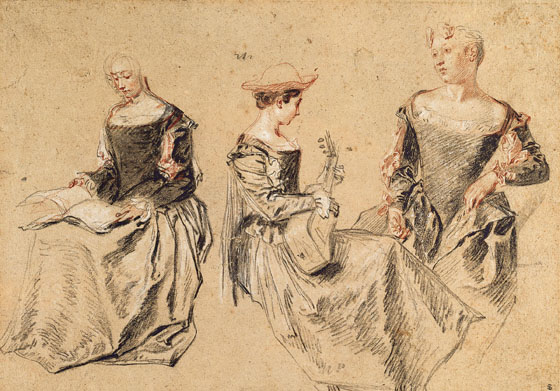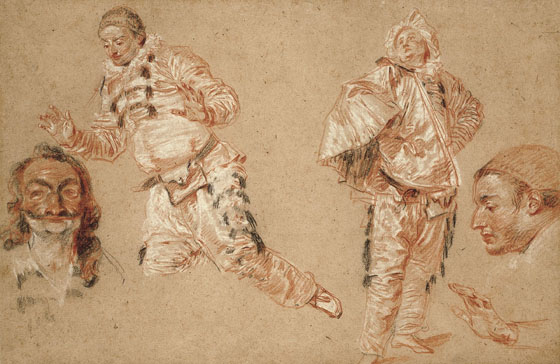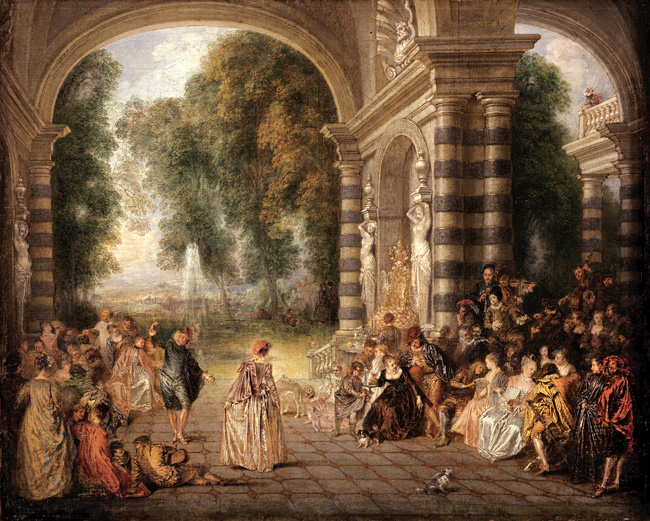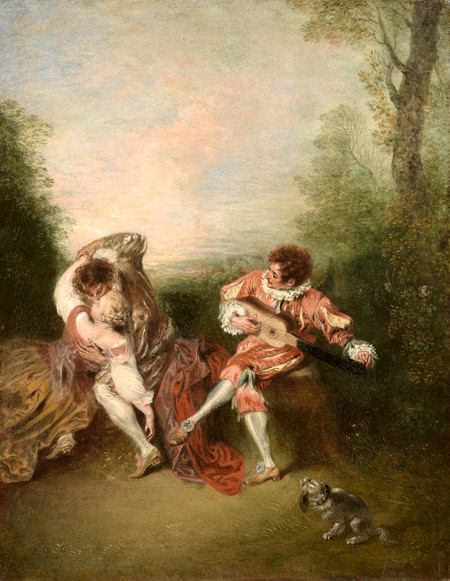Should we let bygones be bygone eras?These are precious, because Watteau’s paintings so unmistakably draw meaning from and give memorable form to a certain now far distant subculture.He is a master of in-between situations….Watteau introduced just such a change of accent. His improvisations bade farewell to the objectives of completeness and coherence spelled out by Poussin in the previous century. “What we are witnessing is something like the death of storytelling” ( Jed Perl ) rather than a lost idyllic past and little symphonies of nostalgia and wistful longings of a bygone era.

Karlin:Watteau’s Woman Reclining on a Chaise Longue from around 1718 is one of his erotic informal poses of women, probably executed at one of the drawing sessions with model arranged for him and a small group of friends. The woman’s hair is pinned up but her fashionable dress has been loosened and her nipples provocatively exposed.
Naggingly, Watteau does seem to pose the question:Does human behavior emerge from style? Idiosyncratic behavior that is obedient to the imperatives of style in the eighteenth-century? A set of abstract rules that constitute style- and in turn, human identity?
When we look at the figures in one of Watteau’s typical paintings, it is difficult not to realize that their gazes, their postures, and their gestures,their whole repertoire of social interactions seems to be extremely ornamental an artificial. We see a number of highly stereotyped gestures of seduction and affectation which represents the grammar of behavior in the times of Watteau. People preferred an endless sequence of prefigured and repetitive ceremonious activities. Their day consisted of ” periodical sighings and kneeling down”. The fancy, ornate figures always convey an aura of the ghostlike.

"Watteau’s drawings played a central role in the composition of his paintings. Unlike artists who would make drawings as studies for paintings, Watteau tended to select existing drawings from his notebooks and adapt them for larger works. He would organize figures into groups, then arrange the groups in a landscape, which often owe a lot to Dutch or Italian art. "
As if there were no real persons; just as the real figures of Watteau’s times were composed of empty gestures, their representation on the canvas are composed on thin and superficial brushstrokes. Watteau’s world, was a world penetrated and permeated by the imperatives of style. Man could only survive in that world as long as he remained in compliance with the discreet but forceful laws of style which governed all of his life.
Watteau’s work does question our present belief that man is no longer constituted by the forming power of style ; a conviction that emerged in the nineteenth-century where style, as Michel Foucault called it, was the “seal of man”, the so-called outward appearance of our unique and particular make-up: style being a matter of internal choice. However, appearances, and well supported arguments to the contrary, such as the art of Van Gogh for example; is it possible that the theory of the autonomous self might be nothing more than a consoling fiction, albeit an extensive and complex one?

"At Watteau’s death, one of his associates destroyed drawings that he thought too "libertine." What a loss. Yet plenty of sexy drawings by Watteau survive, and two other exhibitions of drawings right now provide opportunities to see several of these and invite consideration of their influence on other artists."
It is more pessimistic, but perhaps this dosage of realism is not misplaced in considering style as a result of unintentional processes. In other words, the realm of psychoanalysis; where the “I” , the ego is no longer master in his or her own house. Or the procreator of style. Style becomes the index of the unconscious. What are the options to go beyond style? A “radical modernism” that cancels obligations of style simply creates a new aesthetic in its wake which reverts to a function of art as an exploration of the condition of the possibility to say something within a necessary framework.
From Marcel Duchamp’s point of view, art is basically a social game. Hence the rules of the game cannot be determined by the artist alone. He cannot even get to control them. He can only participate in the game as a gambler. Art is no longer an attempt to speak up in one,s own or some alien language.It rather, becomes a subversive act of commentary on a “ready-made” system of language. Art, as it is conceived by Duchamp, is no longer understandable as a specific use of language; it is at best about language.

"Despite the terrific paintings assembled at the Met, Watteau is better praised by some for his brilliant draughtsmanship. His deft use of "trois crayons," or red, black and white chalk, as in his sheet of studies of Italian Comedians (1719), has never been equaled
he eyes of many connoisseurs. It’s an interest he picked up, again, from Rubens."…Extolling Watteau as the kind of modernist who subscribes to “the questioning of meaning as a new form of meaning,” Perl finds an ally in Samuel Beckett, who, he claims, sensed in the painter’s images “a tragic sense of the mismatch between the figure and the environment.” Do the lake waters and shadowy trees harmonize (as they might in a Poussin) with the characters’ emotions, or isn’t it rather a case of a mute indifference confronting a stalled hesitancy? That “unalterable alienness of the 2 phenomena,” as Beckett expressed it, could be a structural question in the composition of any painting. Figures, of necessity, must be located somehow or other in space. But Watteau’s methods, splicing his theatrical scenarios together from disparate sketches, lent the conjunction a new self-consciousness.( Julian Bell )

Julian Bell:The pictorial veins that Watteau went on to work catered to a craving for imaginative escape that surged among Parisians, who had long been leery of Louis's domineering and bellicose statism. City dwellers, whether aristocratic or bourgeois, found their common language for in-jokes and badinage in the theater. Fashionable taste around 1710 favored shows by the unlicensed players' companies: these featured harlequins and pierrots, in the face of an official ban on Italian commedia dell'arte and of a royal monopoly granted the Comedie-Française. The pursuit of pleasure sent the same crowds out of town on suburban excursions, taking for instance the boat ride down the Seine to Saint-Cloud with its château, its park, and its bowers.
The novelty and impact of Watteau’s art depended on his ability to interweave and transform three elements in early eighteenth-century French culture. First, he took an erotic, playful, inventive, deliberately imaginary, curvilinear style of ornamental decoration called “grotesque” which had traditionally flourished only on the freer, decorative margins of sixteenth and seventeenth-century art and made it the basis of his whole aesthetic. What was been marginal became central. A free imagination safely confined to the edges of serious painting, prints, and tapestry; and given considerable license within those confines now pervaded and transformed court painting.

Watteau. The Surprise."Tokens and encapsulations of that fleeting grace became Watteau's stock-in-trade. With a winning facility at rendering satins, with a constant supply of figure studies fostered by his zeal for sketching, he could conjure up variation after variation out of the stock units of amorously inclined man, amorously susceptible woman, and bosky parkland -- often swelling the numbers into a party ( une fete ), commonly introducing one or more stage personas and very likely a guitar."
Rather than a play of high class burgher decorum as in Rubens’s Love Garden with its more plausible villa, Watteau’s Cythera offered a wholly fictitious justification for an endless game of love with no suggestion of marriage or larger responsibilities. Decorum and restraint were everywhere but these were redefined to be compatible with a much more libertine outlook delighting in games of amorous deceit, seduction, adultery, and melancholy loss. The retreat aspect of Renaissance and Baroque landscape art and villa construction was thus taken further so that Nature became a place where elaborate codes could coexist with an even greater sexual license, especially for men.

"It was only in the 1830s that the critic Arsene Houssaye started to redirect attention to a by then remote cultural phenomenon. In 1856 the return was made official in a long panegyric by the Goncourt brothers, who, like Watteau's contemporaries, spoke of an art devoted to pleasure. But feelings had transmuted during the eclipse. "La Philosophie de Watteau," their essay was provocatively entitled; and the hedonism imputed to the painter proved not entirely simple, for at its heart there was found to be a keynote of "melancholy." Thus the Goncourts set up a line of interpretation that has been orthodoxy ever since. Watteau became the visual poet of yearnings that might never be consummated, of youth that is foolish and brief, of fine charades that tremble with anxiety, of trysts that may end in tristesse. Somehow, the neuroses of the man himself, of which his friends could see no trace in his art, were belatedly discovered to lurk there after all, just beneath the bright colorful surface. No doubt a factor in this turnaround is sheer temporal distance -- the sense that the ancien regime as epitomized in Watteau's work is the great "before," on the other side of the Revolution and industrialization and the Romanticism that spawned the very nostalgia we bring to our viewing, imbuing his images with a pathos beyond their maker's conception."
Just as Watteau transformed courtly pastoral into a pastoralized courtly genre painting, he also transformed mythology. Here on a fabulous island consecrated to Venus, mythology became less an exalted realm of sacred nature, cosmic order, reason, and morality than a realm of theatrical possibilities, of momentary fantasy and role-playing, of theatrical pleasure and play acting, of painting at the service of the erotic imagination: Dionysian visions under a the warm embers of a Promethean fire. The potential for a conflagration was forming.
There is also a larger reality and the reverse side of Watteau’s theatricality. As with all of Watteau’s art, the very evanescence of his imaginary, Cytherean world along with its elaborate costuming and masquerade suggested its own finitude and unreality.A real ove mirrored by an un-real love so to speak. So did the gentle melancholy and self-awareness of Watteau’s figures, qualities banished from the more untroubled, hedonistic pastoral of Boucher and Fragonard later in the century. In the Cythera, the visit of contemporary French courtiers to a mythical island presumed its own brevity and unreality, something heightened by the obvious nostalgia, longing, and regret of the departing figures at right. Here Watteau gave the pursuit of erotic pleasure at least some measure of deeper human reality, some sense of its insubstantiality. And in confronting this unreality, however obliquely, Watteau’s art gave court culture and his own court painting a greater social tension and psychological depth than the unselfconscious, escapist visions developed by more official Rococo artists working for the crown such as Boucher and Fragonard.

Watteau. Pilgrimage to the Isle of Cythera. "Watteau becomes "modern" also in evoking this sense of suburban leisure: the organic descendant of The Pilgrimage to the Isle of Cythera, with its holiday dalliances, its dandyism, and its vaguely busked backdrop, is arguably Manet's Dejeuner sur l'herbe. Cythera is never merely Saint-Cloud, just as Manet does not tie us down to the Bois du Boulogne, yet in each case the image's keen arresting edge surely stems from specific local stimuli."
a





 COMMENTS
COMMENTS
1 I am struck by the similarity between landscapes depicted within paintings by this artist and available descriptions of time slips – the odd perspectives for example, also a sense of underlying unease and ambiguity which these paintings invoke, that is similar to feelings described by those who have experienced slips in time.
2 I would suggest human behaviour comes through style. A good example in the present day is camp.